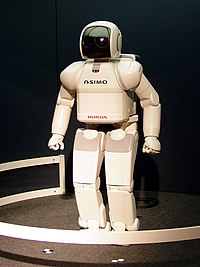
Photo from wikipedia
Surgical robots have been widely adopted with over 4000 robots being used in practice daily. However, these are telerobots that are fully controlled by skilled human surgeons. Introducing “surgeon-assist”—some forms… Click to show full abstract
Surgical robots have been widely adopted with over 4000 robots being used in practice daily. However, these are telerobots that are fully controlled by skilled human surgeons. Introducing “surgeon-assist”—some forms of autonomy—has the potential to reduce tedium and increase consistency, analogous to driver-assist functions for lane-keeping, cruise control, and parking. This article examines the scientific and technical backgrounds of robotic autonomy in surgery and some ethical, social, and legal implications. We describe several autonomous surgical tasks that have been automated in laboratory settings, and research concepts and trends.
Journal Title: Proceedings of the IEEE
Year Published: 2022
Link to full text (if available)
Share on Social Media: Sign Up to like & get
recommendations!